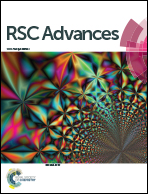Enhancing the charge separation and migration efficiency of Bi2WO6 by hybridizing the P3HT conducting polymer
Abstract
In order to improve the charge separation and migration efficiency, a conducting polymer, poly(3-hexylthiophene) (P3HT), was introduced into a Bi2WO6 photocatalyst. The hall mobility of the P3HT/Bi2WO6 composite and bare Bi2WO6 were 4.7197 × 102 cm2 V−1 s−1 and 3.0159 × 102 cm2 V−1 s−1, respectively, indicating the high charge transfer ability of the P3HT/Bi2WO6 composite. The photo-degradation of a model pollutant, rhodamine B (RhB) under simulated solar light irradiation, demonstrated that the P3HT/Bi2WO6 composite showed more enhanced photocatalytic activity than bare Bi2WO6. The excellent photocatalytic performance of the P3HT/Bi2WO6 composite could be ascribed to the internal electric field formed between n-type Bi2WO6 and p-type P3HT, which facilitates the separation of photo-generated electron–hole pairs, as well as the high charge carrier mobility of P3HT, which can transport the photo-generated holes to the surface of the semiconductor quickly to participate in the oxidation of pollutants.


 Please wait while we load your content...
Please wait while we load your content...